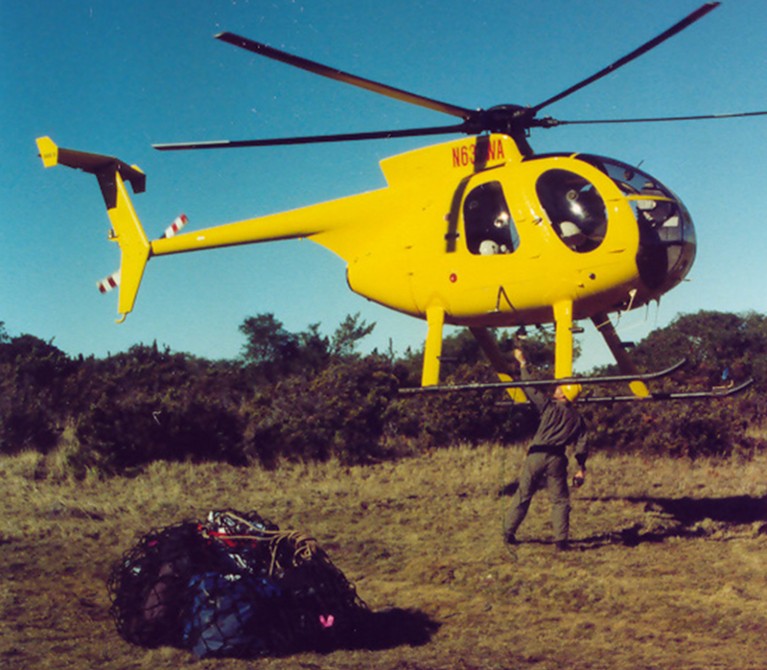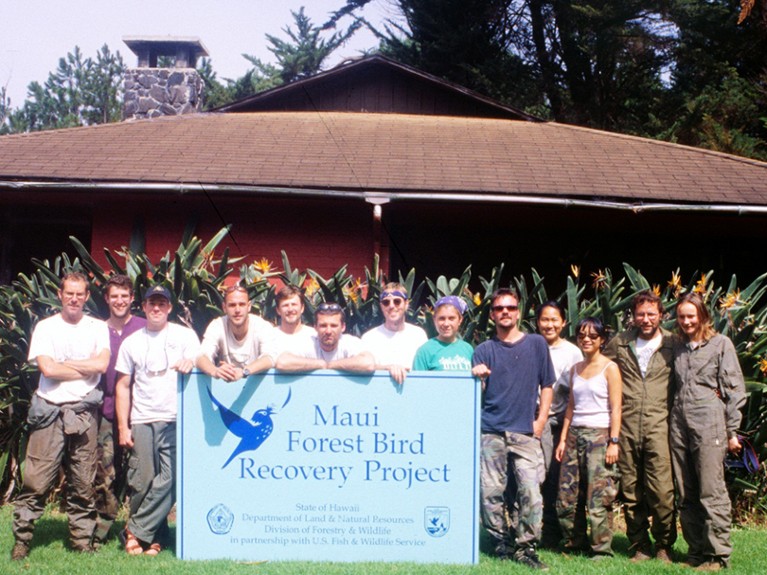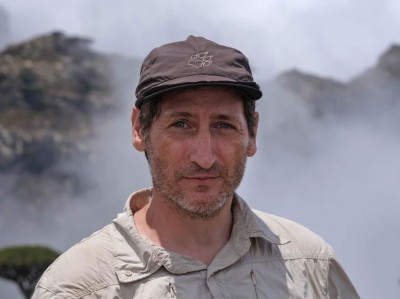
Conservationist Jim Groombridge in Hawaii (standing) performing a ‘heli-hook-up’, in which a net full of equipment is hooked up to the hovering helicopter, to save it needing to land.Credit: Jim Groombridge/Maui Forest Bird Recovery Project
Since his undergraduate degree, Jim Groombridge has been part of several teams that work with critically endangered animals, including the Mauritius kestrel (Falco punctatus), which was brought back from the brink of extinction. But he has also experienced the devastation of some species being lost forever, despite all possible interventions. After receiving his PhD from Queen Mary University of London in 2000, he worked as a project coordinator at the Maui Forest Bird Recovery Project in Makawao, Hawaii. Conservation science spans many topics including climate change, working with local communities, epidemiology, genomics and designing protected areas. Projects can range from single-species conservation to ecosystem-level or landscape conservation, such as restoring whole islands. Now a professor in biodiversity conservation at the University of Kent’s Durrell Institute of Conservation and Ecology in Canterbury, UK, Groombridge teaches bachelor’s and master’s students about leadership of conservation teams and how to motivate them in the face of setbacks.
What is special about leading conservation teams?
Conservation field teams are slightly quirky, and those quirks can define what makes a team work well or not. One is that team leaders are rarely trained in management tasks, such as overseeing a budget, interacting with project partners and local governments, dealing with team members who feel passionate about what they do and facing the high stakes involved. Team members are enthusiastic, passionate and seldom motivated by money.
Another quirk is that, in a small conservation team of four to six people, there is often a mix of skill sets and experience. You can have highly experienced specialists in a particular area, such as screening parrots for diseases, or reintroduction biology, and you might also have volunteers with only passion and enthusiasm to offer.
How do you lead a team with such variable experience?
Even with those different levels of expertise, you still need to meet high standards for specimen and data collection. At the moment, for example, I’m sequencing the genome of the pink pigeon (Nesoenas mayeri), using samples collected in the 1990s. There’s a sense of responsibility, especially if you’re working with species that are rare, because if you mess it up, they could go extinct. It’s not unusual to have volunteers with only two or three weeks’ worth of experience handling extremely rare samples or working with valuable data sets. Their learning curve is pretty steep. As a leader, you need to make sure that you understand the details — ranging from tasks such as collecting data and monitoring and recording invasive species to, for example, knowing how to trap a mongoose — so that you can make sure that everyone is collecting the data in the same way.

Jim Groombridge (far left), who studies biodiversity conservation at the University of Kent, UK, with one of the field crews involved in an operation to translocate a bird called the po‘ouli in Hawaii.Credit: Jim Groombridge/Maui Forest Bird Recovery Project
What do team members tend to have in common?
They often share a passion for nature. They want to save the environment, they want to save a species from going extinct, they want to make a difference. That level of emotion is important. It creates an energy, which needs to be channelled proactively and positively into the project to make it a success.
In 2002, for example, I was leading a team working to save a bird called the po‘ouli (Melamprosops phaeosoma) on the island of Maui, part of the Hawaiian archipelago. We were trying to translocate one of the last known birds into the range of another one to give them the opportunity to breed. There was huge excitement, but after four weeks of failing to catch the bird, there was also a lot of frustration.
How do you manage a team with such strong emotions?
Morale is really important. So is being able to deal with difficulties when they arise. That’s what gets small teams through tough times. With the po‘ouli, I had to make sure that the team had fun, and that people genuinely enjoyed themselves. That meant taking time out with the team in the evenings and ensuring that everyone had a bit of a laugh, so it wasn’t deadly serious all the time. Also, I made sure that team members got to perform the aspects of the job that they were good at, to increase their confidence and well-being. We eventually trapped the po‘ouli and moved it, but even though the birds were in the same territory, they didn’t breed.
How do you manage expectations amid failure?
I had to remind the team about the broader picture of what we had achieved. This was the first time anyone had followed the po‘ouli in the forest for ten days. I think we learnt more about the ecology of that species in that time than anyone had learnt in 30 years. We held the translocated bird for about two hours before we released it, and it took food items from us, which showed that the birds could be kept in captivity if necessary. We learnt a huge amount that could be applied to another project.
Treading carefully: saving frankincense trees in Yemen
You have to manage people’s expectations and have goals that are achievable. If you are starting a project on a species with fewer than ten individuals left in the wild, and your goal is to have thousands, that’s a difficult leap of imagination. Instead, perhaps start with finding a food that a species would eat in captivity. People need to remain connected with what’s achievable. There’s a delicate balance between being aspirational and being pragmatic.
As a team member, what do you wish more conservation leaders knew?
Often, there is too much emphasis placed on the command structure. Innovation in a conservation team is undersold, and easily quashed by a type of line-manager approach. The hierarchy in a team is important because people know what to do and who to report to, but you also have to encourage team members to use their initiative and ask questions. I remember when my team and I were in the cloud forests, tropical mountain regions covered by clouds for most of the year in Hawaii, we were struggling with baiting rats, which prey on eggs and fledglings of native birds. It’s one of the wettest places on Earth, and the rat poison basically turns to cottage cheese. However, one of my colleagues designed a bait box, which kept the bait dry for many weeks. When you’re working with critically endangered species and in field conditions, ingenuity is crucial.

 Treading carefully: saving frankincense trees in Yemen
Treading carefully: saving frankincense trees in Yemen
 It’s time to make science in remote places family-friendly
It’s time to make science in remote places family-friendly
 Outside the lab: Field your A Team
Outside the lab: Field your A Team





